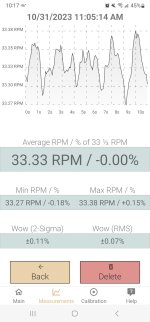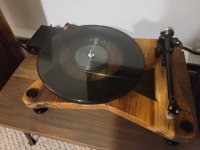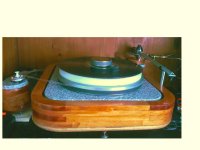I went down a rabbit hole with my custom belt drive turntable, testing various combos of belts, belt material, and pulleys. I came to a couple of conclusions. I built an Arduino speed controller with SineWave/SpaceVector control of a 3 Phase motor for very stable motor performance, so focused on the belt and pulley to really get the last bit of optimal speed control out of my system.
My observations:
1) round silicone belts are terrible for speed consistancy, they move A LOT
2) EPDM round belts are pretty good
3) dual round belts are better than single belts, but have weird spikes in speed stability
4) cheap flat belts are better than round belts, but require a pulley that can keep a flat belt centered.
I have a very nice crowned flat belt pulley, but the one pulley that provided the best performance? A GT2 timing belt pulley. WITH RIDGES!!
I am wondering why. Does a smooth flat belt pulley load a lot of the tension at the two ends (aka stretch before the belt engages the pulley, slack after it releases)? Is a timing pulley performing better because the gaps during rotation allow smoothing of the belt tension during pulley rotation?
My observations:
1) round silicone belts are terrible for speed consistancy, they move A LOT
2) EPDM round belts are pretty good
3) dual round belts are better than single belts, but have weird spikes in speed stability
4) cheap flat belts are better than round belts, but require a pulley that can keep a flat belt centered.
I have a very nice crowned flat belt pulley, but the one pulley that provided the best performance? A GT2 timing belt pulley. WITH RIDGES!!
I am wondering why. Does a smooth flat belt pulley load a lot of the tension at the two ends (aka stretch before the belt engages the pulley, slack after it releases)? Is a timing pulley performing better because the gaps during rotation allow smoothing of the belt tension during pulley rotation?
Attachments
Rather than being the ridges that caused better performance, maybe it's the 'crowned' pulley causing worse. Did you try a cylindrical pulley with side flanges to keep the belt centred (like the ridged pulley)? I suppose this isn't a good idea generally as the belt might make noise rubbing on the flanges, and this friction also might affect speed stability. But just a thought.
One other thing that might be an issue is a slight whir from the ridges, being transmitted through the belt to the platter. Just putting that out there; I know it's probably unlikely.
One other thing that might be an issue is a slight whir from the ridges, being transmitted through the belt to the platter. Just putting that out there; I know it's probably unlikely.
Hi,
which device did u use to check the platter speed? Perhaps a platter with more inertia may change some results?
Tks n rgds
Adelmo
which device did u use to check the platter speed? Perhaps a platter with more inertia may change some results?
Tks n rgds
Adelmo
Last edited by a moderator:
I used a phone app to measure the platter speed. My existing platter is the Rega Planar 6 platter at about 4-5lbs I think.
yes, that type of pulley made the flat belt move up the flange. It needed the crowned pulley to stay centered.cylindrical pulley with side flanges to keep the belt centred (like the ridged pulley)
Hi, Interesting, smallest internal diameter on the pulley I can find is 3mm, for my motor I need 2.9!!
Just a note, your 33.33 may be spot on, but the Wow at 0.11 is way TOOOOO high. Mine is 0.06 using a DC motor.
Also the speed on that app is not correct, at least on my mobile, measuring about 2% slow according to two of my other T/T's with strobes.
You also did not test the best best material for belts & that is Mylar.
Cheers
Just a note, your 33.33 may be spot on, but the Wow at 0.11 is way TOOOOO high. Mine is 0.06 using a DC motor.
Also the speed on that app is not correct, at least on my mobile, measuring about 2% slow according to two of my other T/T's with strobes.
You also did not test the best best material for belts & that is Mylar.
Cheers
Many pullyes are bell-shaped and then the belt will automatically ride on the fattest part of the pulley.
Jan
Jan
We've recently found that the computers at work have been measuring frequencies with quite a bit of error, the new computers are ok though. I thought that computers would be very accurate in this regard, but you live and learn - I have no idea how accurate phones are.
I am using a 3 Phase Brushless DC motor. I can actually get the WOW down to 0.05, but that requires running a bit more current through the motor and it gets warm/hot. Totally fine for the motor, but right now I am trying to optimize as much as I can running at a lower current.your 33.33 may be spot on, but the Wow at 0.11 is way TOOOOO high. Mine is 0.06 using a DC motor.
And I listened to both what I have it at now, and running hot for extra motor control. I really did not hear any difference at this level. I did hear significant wobble on sustained notes when the wow was up at 0.20 with initial un-optimized settings, but I adjusted my motor control to get it down.
Also, I tried mylar type. I am not good a splicing so that there is uniform thickness over the whole belt. I could detect spikes (both via measurement and audibly) when the thicker part passed over the pulley from my crude splice attempt. I also tried thread, same issue with the knot.
that the computers at work have been measuring frequencies with quite a bit of error
Interesting enough, I went through that same issue with my motor controller boards (Arduinos and STMicro STM32 boards). Jazzboy on this forum did as well. We found that the old Arduino R3 used a crystall oscillator for timing, and the new R4 did not (relying on an on chip oscillator). And only a very specific STM32 board had a crystal. That crystal meant you could lock in freq accuracy to a fine degree. Non- crystal boards had freq drift and variability for this application arounf 2%, and it drifted over time as well.
''Also, I tried mylar type. I am not good a splicing so that there is uniform thickness over the whole belt. I could detect spikes (both via measurement and audibly''
To get Mylar to run smoothly you need to cut both end at about 20 to 30 degrees, so they have a long taper. With my belt my wow at 0.05.
The only people who need a T/T to run at 33.33RPM are the lucky people with perfect pitch. (about 0.1% of the population.)
Low wow (under 0.06%) is much more important as it is easy to pick (for me at least) on sustained piano.
Cheers & happy experimenting.
To get Mylar to run smoothly you need to cut both end at about 20 to 30 degrees, so they have a long taper. With my belt my wow at 0.05.
The only people who need a T/T to run at 33.33RPM are the lucky people with perfect pitch. (about 0.1% of the population.)
Low wow (under 0.06%) is much more important as it is easy to pick (for me at least) on sustained piano.
Cheers & happy experimenting.
I used a phone app to measure the platter speed. My existing platter is the Rega Planar 6 platter at about 4-5lbs I think.
yes, that type of pulley made the flat belt move up the flange. It needed the crowned pulley to stay centered.
Hi,
I think the phone app is not an enough reliable device to take any true conclusion on this issue. In other forum there were mods to improve the speed issue on Rega TT. They changed the sub platter, added peripheral weight to the platter, changed the round belt.....
Rgds
Adelmo
I used a phone app to measure the platter speed. My existing platter is the Rega Planar 6 platter at about 4-5lbs I think.
yes, that type of pulley made the flat belt move up the flange. It needed the crowned pulley to stay centered.
HI,
If motor pulley and sub platter plane surface are perfectly alined and able to keep that position the belt would not move neither up neither down position .
Rgds
Adelmo
I'm currently using silk embroidery thread with the Micro Seiki knot. It always runs on the outside.I also tried thread, same issue with the knot.
I could use a better motor drive system.
Pete
So finny thing with belt physics. It is not the inside of the belt that matters. It is the middle. So a knot changes the thickness at that point and creates a bump in speed variation. Uniform thickness of the belt media is quite important.It always runs on the outsid
Hi, Always the key to a DIY T/T is to 1st use a HEAVY, Balanced platter. That ensured that the rotation is balanced out, due to the rotation torque of the platter, once spinning. I use a Lenco 78 balanced platter with my Mylar belt going around its periphery.
I have also tried various string belts & have got reasonable performance from them. (but not as good as Mylar) The main trick with these is to make them at least 4 looped lengths of the perimeter, then the effects of the knot is essentially, but not fully minimized.
Cheers
I have also tried various string belts & have got reasonable performance from them. (but not as good as Mylar) The main trick with these is to make them at least 4 looped lengths of the perimeter, then the effects of the knot is essentially, but not fully minimized.
Cheers
Attachments
I don't quite understand what you mean. My thread runs on the circumference of the 8" air bearing. How long should my thread be?The main trick with these is to make them at least 4 looped lengths of the perimeter
Pete
Or you can be smart and realize its just an exercise in low-pass filter design, adding more poles is the easy fix. Two modest sized platters on top of each other with rubber spacer? The belt drives one, then that drives the second via this second low-pass coupling.Hi, Always the key to a DIY T/T is to 1st use a HEAVY, Balanced platter.
Hi,
Thread Length. Pete. All you need to do is cut the length of thread 4 x longer, Then Loop them into the into one length.
Platter design. Mark, completely an option. just a little harder to get the top platter aligned correctly. I have done one similar with pointed grub screws.
Cheers
Thread Length. Pete. All you need to do is cut the length of thread 4 x longer, Then Loop them into the into one length.
Platter design. Mark, completely an option. just a little harder to get the top platter aligned correctly. I have done one similar with pointed grub screws.
Cheers
4 x longer than what?cut the length of thread 4 x longer
Currently my motor is 18 inches away from the spindle and my loop is 22 inches.
Pete
- Home
- Source & Line
- Analogue Source
- Pulleys - interesting observation


